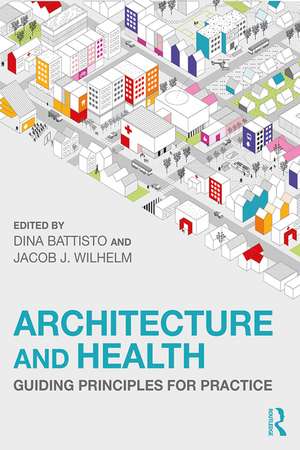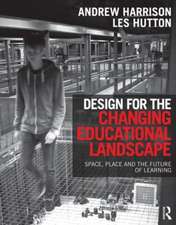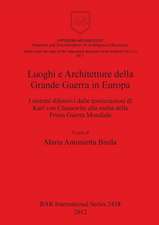Architecture and Health: Guiding Principles for Practice
Autor Diana Battistoen Limba Engleză Paperback – 24 oct 2019
Architecture and Health recognizes the built environment and health as inextricable encouraging a new mindset for the profession. Over forty international award-winning projects are included to explore innovative design principles linked to health outcomes. The book is organized into three interdependent health domains--individual, community, and global--in which each case study proposes context-specific architectural responses. Case studies include children's hospitals, rehabilitation facilities, elderly housing, mental health facilities, cancer-support centers, clinics, healthy communities, healthcare campuses, wellness centers, healing gardens, commercial offices, infrastructure for developing countries, sustainable design, and more. Representing the United States, Africa, Asia, Europe, and Australia, each author brings a new perspective to health and its related architectural response.
This book brings a timely focus to a subject matter commonly constricted by normative building practices and transforms the dialogue into one of creativity and innovation. With over 200 color images, this book is an essential read for architects, designers, and students to explore and analyze designed environments that promote health and well-being.
Preț: 361.42 lei
Nou
69.16€ • 72.35$ • 57.45£
Carte disponibilă
Livrare economică 13-27 martie
Livrare express 26 februarie-04 martie pentru 50.10 lei
Specificații
ISBN-10: 0367075229
Pagini: 412
Ilustrații: 13 Tables, color; 77 Line drawings, color; 160 Halftones, color
Dimensiuni: 178 x 254 x 18 mm
Greutate: 0.91 kg
Ediția:1
Editura: Taylor & Francis
Colecția Routledge
Locul publicării:Oxford, United Kingdom
Public țintă
General, Postgraduate, Professional, Professional Practice & Development, and UndergraduateCuprins
Acknowledgments
Key Terms
- Introduction: Discovering an Architecture for Health
Dina Battisto and Jacob J. Wilhelm
Part 1: Individual Health - Healthcare Facilities for Children: Designing for Distinct Age GroupsAllen Buie
- Elderly Autonomy through Architecture: Building a Fifth-Generation Residential Care HomeDietger Wissounig and Birgit Prack
- Advancing Rehabilitation: Design that Considers Physical and Cognitive DisabilitiesBrenna Costello
- Design Attributes for Improved Mental and Behavioral HealthMardelle McCuskey Shepley and Naomi A. Sachs
- Renewing the Human Spirit Through Design: Celebrating Maggie’s CentresJamie Mitchell
Part 2: Community Health - Creating Healthy Communities Through Wellness Districts and Health CampusesShannon Kraus, Kate Renner, Dina Battisto, and Brett Jacobs
- Superhospitals: The Next Generation of Public Hospitals in ScandinaviaKlavs Hyttel
- A Rebirth of the Consolidated Health Campus: The New Parkland HospitalMatthew Suarez and James J. Atkinson
- Defining a Project Method: Ensuring Project Success with Pre-Design PlanningHarm Hollander
- The Efficacy of Healing Gardens: Integrating Landscape Architecture for HealthKatharina Nieberler-Walker, Cheryl Desha, Omniya El Baghdadi, and Angela Reeve
- Lean Design: The Everett Clinic at Smokey PointBarbara Anderson, Melanie Yaris, and Julia Leitman
- Employee Wellness: The Dan Abraham Healthy Living Center at Mayo ClinicPeter G. Smith and Stephen N. Berg
- From Vice to Wellness: Defining a New Typology in Healthcare Retail DesignMegan Stone
Part 3: Global Health - Outdoor Oncology: A Nature-Inclusive Approach to Healthcare DeliveryBart van der Salm
- Living Buildings: The Bullitt CenterSteve Doub, Jim Hanford, Margaret Sprug, Chris Hellstern, and Katherine Misel
- Regenerative Architecture: Redefining Progress in the Built EnvironmentRobin Guenther
- A Blueprint for Using Renewable Energies in Remote LocationsChristopher W. Kiss and Keith Holloway
- Integrating LEED with Biophilic Design Attributes: Towards an Inclusive Rating SystemStephen Verderber and Terri Peters
- Connecting to Context: Place-Based Approaches to Biophilic Healthcare DesignMara Baum
- The Anti-Prototype: Why Community Health Requires Local SolutionsMichael Murphy, Amie Shao, and Jeffrey Mansfield
- Epilogue: The Future of an Architecture for Health
About the Editors
List of Contributors
Index
Notă biografică
Jacob J. Wilhelm works in architectural practice and publication, exploring hospitality, housing, and vernacular solutions for growing mountain and remote regions.
Recenzii
Joyce Durham RN, AIA, EDAC, Director of Facilities Strategic Planning; New York-Presbyterian
"Architecture and Health reflects the broadened identity of both the architecture and health professions: architects now recognize that their responsibilities include the global built environment, while health professionals have begun to embrace global health and well-being as central to their work. The essays in this book also help us understand why that change has happened: both our built environment and our health system are unsustainable, inequitable, and unaffordable in their current form."
Thomas Fisher Professor, School of Architecture; Director, Minnesota Design Center, University of Minnesota
Descriere
Architecture and Health recognizes the built environment and health as inextricable encouraging a new mindset for the profession. Over forty international award-winning projects are included to explore innovative design principles linked to health outcomes. The book is organized into three interdependent health domains--individual, community, and global--in which each case study proposes context-specific architectural responses. Case studies include children's hospitals, rehabilitation facilities, elderly housing, mental health facilities, cancer-support centers, clinics, healthy communities, healthcare campuses, wellness centers, healing gardens, commercial offices, infrastructure for developing countries, sustainable design, and more. Representing the United States, Africa, Asia, Europe, and Australia, each author brings a new perspective to health and its related architectural response.
This book brings a timely focus to a subject matter commonly constricted by normative building practices and transforms the dialogue into one of creativity and innovation. With over 200 color images, this book is an essential read for architects, designers, and students to explore and analyze designed environments that promote health and well-being.






